
Danaus genutia, the common tiger, is one of the common butterflies of India. It belongs to the "crows and tigers", that is, the Danainae group of the brush-footed butterflies family. The butterfly is also called striped tiger in India to differentiate it from the equally common plain tiger, Danaus chrysippus. The species was first described by Pieter Cramer in 1779.
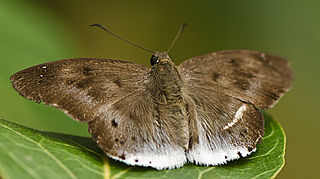
Tagiades japetus, commonly known as the pied flat or the common snow flat, is a species of spread-winged skipper butterfly belonging to the family Hesperiidae. It is widely distributed, being found from India, the Himalayas, Southeast Asia, to Australia. It contains several recognized subspecies.

Papilio ulysses, the Ulysses butterfly, is a large swallowtail butterfly, in the subgenus Achillides, of Australia, Indonesia, Papua New Guinea and the Solomon Islands. Its size varies depending on subspecies, but the wingspan is about 10.5 cm (4.1 in) in Queensland.

Ornithoptera priamus, the common green birdwing, Cape York birdwing, Priam's birdwing, northern birdwing or New Guinea birdwing is a widespread species of birdwing butterfly found in the central and south Moluccas, New Guinea, Bismarck Archipelago, Solomon Islands, and north-east Australia.

Orsotriaena medus is a butterfly found in south Asia, southeast Asia, and Australia. It is the only species in the genus Orsotriaena, first described by Hans Daniel Johan Wallengren in 1858.

Erebia euryale, the large ringlet, is a species of butterfly belonging to the family Nymphalidae.
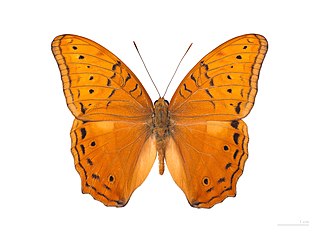
Vindula arsinoe, the cruiser, is a butterfly from the family Nymphalidae. It ranges from the Maluku Islands and New Guinea to the Solomon Islands and Queensland. It is sexually dimorphic.
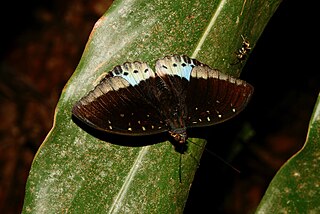
Lexias pardalis, the common archduke, is a butterfly of the family Nymphalidae.
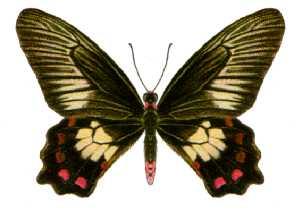
Pachliopta polydorus, the red-bodied swallowtail, is a butterfly from the family Papilionidae found in north-eastern Queensland, Australia and Papua New Guinea.

Junonia orithya is a nymphalid butterfly with many subspecies occurring from Africa, through southern and south-eastern Asia, and in Australia. In India, its common English name is the blue pansy, but in southern Africa it is known as the eyed pansy as the name blue pansy refers to Junonia oenone. In Australia, this butterfly is known as the blue argus, but this name also is used for the Aricia anteros in Europe.

Troides amphrysus, the Malay birdwing, is a birdwing butterfly in the genus Troides in the family Papilionidae.

Heliconius numata, the Numata longwing, is a brush-footed butterfly species belonging to the family Nymphalidae, subfamily Heliconiinae.

Eryphanis automedon, the Automedon giant owl, is a species of butterfly belonging to the family Nymphalidae.
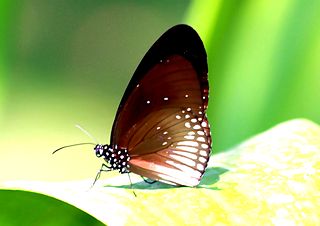
Euploea alcathoe, commonly known as the no-brand crow, Eichhorn's crow or striped black crow, is a common butterfly found from India to Borneo, and in the Moluccas, New Guinea and Australia. It belongs to the crows and tigers subfamily of the Nymphalidae.
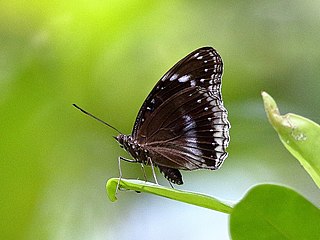
Hypolimnas alimena, the blue-banded eggfly, is a species of butterfly in the family Nymphalidae. It is found in the Solomon Islands, Indonesia, New Guinea and Australia.

Mycalesis terminus, the orange bushbrown, is a species of butterfly in the family Nymphalidae. It is found in Indonesia, New Guinea and Australia (Queensland).

Nacaduba cyanea, the tailed green-banded line-blue, is a species of butterfly in the family Lycaenidae, and formerly considered a member of the genus Danis. It is found in the Indonesia, Papua New Guinea, the Solomon Islands and Australia (Queensland).

Cyrestis acilia is a butterfly in the family Nymphalidae. It is found in Sulawesi the Australasian realm including Sulawesi mainland, Buton island, Kabaena island and Wowoni island. See subspecies.
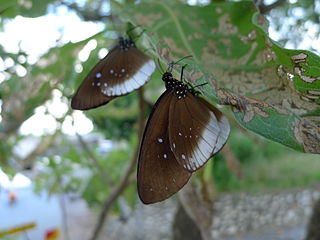
Euploea climena is a butterfly in the family Nymphalidae. It was described by Caspar Stoll in 1782. It is found in the Indomalayan realm and the Australasian realm.
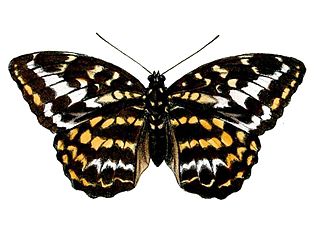
Lexias canescens, the yellow archduke, is a species of butterfly belonging to the family Nymphalidae. It was first described by Arthur Gardiner Butler in 1869.





















